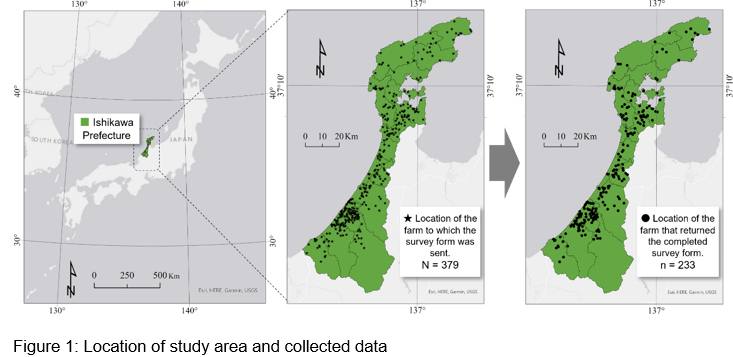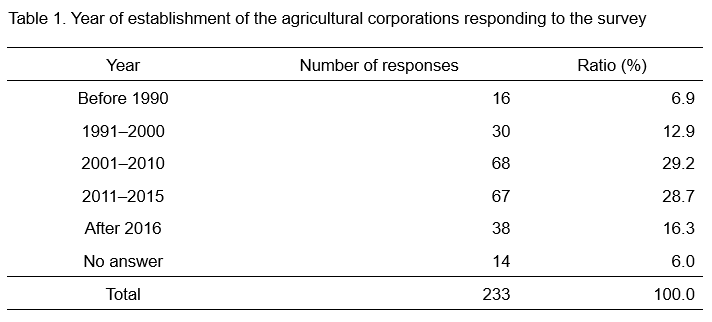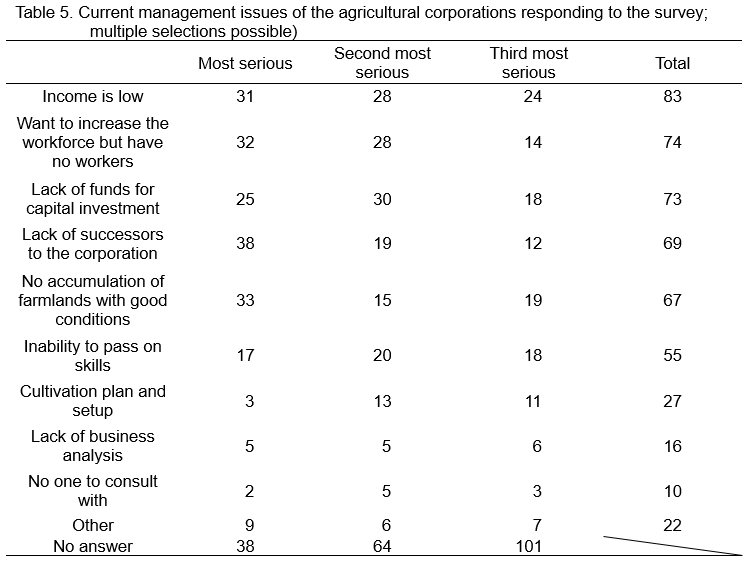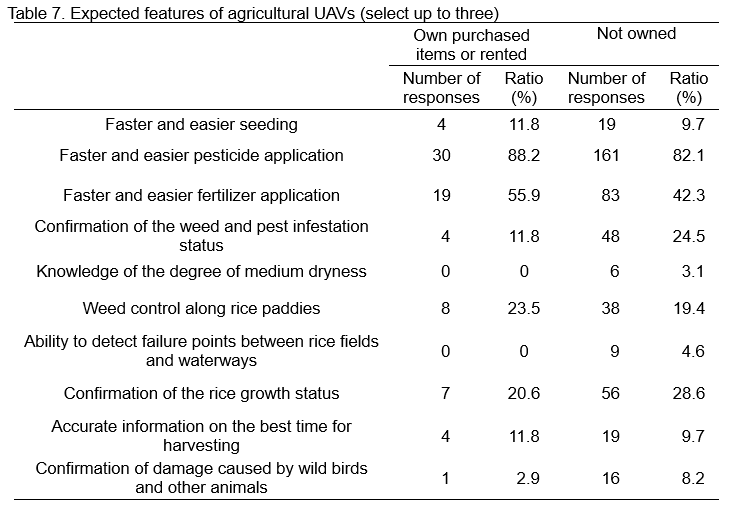ABSTRACT
In recent years, smart agriculture has been promoted as a means of reducing wastes in rice farming in Japan, departing from conventional farming methods. We focus on Unmanned Aerial Vehicles (UAVs)—Internet-of-Things (IoT) technologies that could bring innovation to the rice farming sector in Japan and whose performance has been remarkably improved in recent years. With the aging population, particularly in rural areas, and the rapid decline in the number of farmers, it is essential to improve agricultural productivity by reducing the workload. In this study, we examine the potential for diffusion of innovative new technologies, including intentions, perceptions, expected uses, and conditions for the adoption of UAVs, using Ishikawa Prefecture, Japan, as a case study area. We conducted a questionnaire survey among all agricultural corporations in Ishikawa Prefecture, Japan; of the 370 corporations surveyed, 233 responded. The results showed that the percentage of UAVs owned (including rental ones) at present is 14.6%; thus, they are in the early stage of the diffusion process. However, the willingness to pay for UAVs with the desired functions was 28% lower among the unutilized respondents, which indicates that the equipment’s price is also an issue.
Keywords: UAVs, paddy farming, smart farming, agricultural corporation, Ishikawa prefecture
INTRODUCTION
In the global agricultural sector, smart agriculture using the Internet of Things (IoT) has emerged as an expanding domain, with significant participation from major global IT companies (Farooq et al., 2019). Regarding rice cultivation in Japan, smart agriculture has been promoted in recent years as a means of reducing farming wastes and moving away from conventional farming methods. In particular, an IoT technology that is most likely to become widespread is the so-called Unmanned Aerial Vehicles (hereinafter referred to as UAVs), which could bring innovation to the rice farming sector in Japan and whose performance has recently been remarkably advanced. The development of sensor performance has already led to optimal path selection to avoid various obstacles on the ground (Duangsuwan & Maw, 2021) and low-altitude flight (Qiu et al., 2017), and they are now in the practical stage. In this study, we examine the conditions for the diffusion of UAVs in paddy farming (hereinafter referred to as UPF) in Japan as a case study.
In Japan, UAVs are currently spreading (MAFF, 2023). With population aging, especially in rural areas, and the rapid decline in the number of farmers, it is essential to improve agricultural productivity by reducing the workload. However, little is known about the status of UPF not only among elite farmers who lead government organizations, companies, and research periods and technological development but also among ordinary farmers. In particular, as the mainstream agricultural policy regarding rice cultivation in Japan focuses on farmland accumulation by specific core farming enterprises, the UPF intentions of these enterprises will play a key role in the future sustainability of rice cultivation.
In this study, we discuss the diffusion potential of innovative new technologies, including intentions, perceptions, expected uses, and adoption conditions for UPF, using Ishikawa Prefecture, Japan, as a case study. This discussion is expected to serve as a cornerstone for the sustainability of rice cultivation not only in Japan but also in East and Southeast Asian countries, where rice is a staple food.
STUDY AREA AND PARTICIPANTS
Ishikawa Prefecture, located in the Sea of Japan side of the Japanese archipelago, is the study area. This prefecture was the origin of Japan’s land consolidation policy, which led to a large-scale conversion of agricultural land approximately 150 years ago (ARIC, 2020). Since then, Ishikawa Prefecture has shown a strong tendency to consolidate the management of small-scale farmland among core farmers or to form community-based farming organizations for collective management. These farm management entities have been converting to agricultural corporations[1], in line with the recent Japanese agricultural policy trend, encouraging a shift from conventional management to modern corporate farming management.
In this study, we surveyed the agricultural corporations in Ishikawa Prefecture as of 2019, which corresponds to the time the study was conducted, to examine the current intentions of agricultural corporations regarding UPF.
DATA
We used a list of all agricultural corporations collected by a research group of the Ishikawa Prefectural Government that gathers management information on agricultural corporations. This list is not available to the public because it contains confidential information. Questionnaires were mailed to 379 respondents, excluding those whose location were unknown or whose headquarters were outside Ishikawa Prefecture. The 233 cases of those who responded were used as data for the analysis (see Figure 1). The survey was conducted in December 2021.

The survey items included information on the management situation of agricultural corporations, management issues in the past few years, ownership status of UAVs, expected functions of UAVs, and willingness to pay for UAVs. For those agricultural corporations that already own UAVs, we asked about their willingness to pay for hypothetical UAVs equipped with the expected functions in addition to the ones they currently owned. In addition, an optional text field was provided as an open-ended response to capture detailed needs.
First, Tables 1–5 show the general situation of the corporations that participated in the survey. Regarding the year of establishment of agricultural corporations (Table 1), only 6.9% were established before 1990, and the number has been increasing since 1991, when agricultural incorporation was promoted as a policy matter.

In Table 2, the average values of the number of members and employees show that 13.6 were members, 5.5 were permanent employees, and 6.7 were temporary employees. Corporations with foreign technical interns were 27, with an average of 0.3. The results for foreign technical interns may have been influenced by the small number of foreign technical interns during the COVID-19 pandemic.

Table 3 summarizes management types by crop type; it shows that paddy rice was the most common, accounting for 88.8% of all responding corporations, with 207 cases. Approximately 65% of the respondents were engaged in “rice only, rice + wheat, soybeans, or vegetables, or rice + wheat, soybeans, or vegetables,” indicating that most of the survey respondents were engaged in land-use management centered on rice cultivation.

The figures in Table 4 regarding owned land, borrowed land, and work consignment areas indicate that the responding entities are relatively large-scale operations when compared to the average management area (sum of owned land and borrowed land areas) in Japan, which is about 3 ha (MAFF, 2021).

Finally, respondents were asked to select three of the ten options presented regarding management problems in the last few years in order of severity (Table 5). The issue is whether the concerns of the agricultural corporations shown in Table 5 are related to the functions expected of UAVs.

RESULTS AND DISCUSSION
Table 6 shows the ownership status of agricultural UAVs. Only 26 respondents (11.2%) stated that they had purchased UAVs, and eight respondents (3.4%) reported that they had purchased them for rent, indicating that most agricultural corporations did not own agricultural UAVs. In other words, UAVs can expand if their functions meet the expectations of agricultural corporations.

Table 7 shows the results of the expected functions of UAVs, with a maximum of three selections, according to whether UAVs are owned or not. Agricultural corporations that already owned UAVs selected the functions that they expected to be enhanced in the future. Functions with several responses can be considered items that developers should focus on in the future.

Table 7 shows that, although there was no significant difference between the groups that owned UAVs and those that did not, the non-holding groups responded more frequently to “checking the occurrence of weeds and pests,” “checking the growth status of rice plants,” and “checking damage by wild birds and animals.” These items correspond to the tasks that farmers perform when they visit the farmland frequently during the annual farm work process and check them visually. In other words, farmers in the non-owning group expect a reduction in the time required for monitoring rice, including the travel time to visit each farmland. First, the development of UAVs with these enhanced functions may lead to the expansion of UAVs. In addition, if agricultural plans are implemented such that the farmland to be managed is not scattered but clustered as close as possible, the time required for visits will be reduced. However, as many respondents reported that “farmland with good conditions is not accumulated” as the most serious problem about the management issues shown in Table 5, it can be inferred that the current situation of farmland location accumulation is not progressing smoothly.
Finally, Table 8 shows the willingness to pay for agricultural UAVs with the expected functions by ownership status. Table 8 shows that the willingness to pay is approximately 28% lower for those who do not own UAVs than for those who do. “In addition to the previously mentioned technical challenges and issues related to farmland accumulation, obstacles to the diffusion of UAVs also encompass pricing concerns.” In this respect, too, agricultural authorities must decide whether to promote rapid diffusion through public financial support or to expect future corporate efforts by manufacturers. The actual willingness to pay may be even lower due to the learning cost of new technology, which is a necessary cost in the early stage of technological innovation.

CONCLUSION
This study examined the conditions for the diffusion of agricultural UAVs as a means of increasing the sustainability of rice farming against the aging farming population and decreasing number of farmers. In the study area, a rural community in Japan, rice farming is likely to be taken over by some core farmers and agricultural corporations in the future. Therefore, we clarified issues related to the expansion of UPF by understanding the needs of management entities.
We concluded that the conditions for the expansion of UPF include formulating and implementing farmland accumulation plans based on clarifying the status of farmland use and prospects in each region, in addition to functionally enhancing the facility.
Furthermore, the willingness to pay for UAVs of agricultural corporations in the non-ownership group was significantly lower than that of agricultural corporations in the ownership group; this suggests that factors hindering the smooth spread of UAVs are rooted in pricing considerations. UAVs are becoming increasingly functional and cheaper. It is thus necessary for agricultural management research to constantly explore new problems and update the understanding of users’ needs.
FUNDING
This work was supported by the National Institute of Agriculture, Forestry, and Fisheries Policy Research Grant 2018, Grant-in-Aid for Scientific Research -KAKENHI - [21H02299, 22K18353].
REFERENCES
ARIC. (2020, August 17). Kaga wo Tagayashita Hitobito [People who created Kaga]. SUIDO NO ISHIZUE [Cornerstone of farmland]. https://suido-ishizue.jp/nihon/03/index.html (In Japanese)
Duangsuwan, S., & Maw, M. M. (2021). Comparison of path loss prediction models for UAV and IoT air-to-ground communication system in rural precision farming environment. Journal of Communications, 16(2), 60–66. https://doi.org/10.12720/jcm.16.2.60-66
Farooq, M. S., Riaz, S., Abid, A., Abid, K., & Naeem, M. A. (2019). A survey on the role of IoT in agriculture for the implementation of smart farming. IEEE Access, 7, 156237–156271. https://doi.org/10.1109/ACCESS.2019.2949703
MAFF. (2021, June 11). Summary of 2020 Census of Agriculture and Forestry Results. Ministry of Agriculture, Forestry and Fisheries. https://www.maff.go.jp/j/tokei/kekka_gaiyou/noucen/2020/index.html (In Japanese)
MAFF. (2023, March 6). Utilization status of drones in the agricultural sector for the fiscal year 2022 (Reiwa 4). Ministry of Agriculture, Forestry and Fisheries. https://www.maff.go.jp/j/kanbo/smart/attach/pdf/drone-26.pdf (In Japanese)
Qiu, Z., Chu, X., Calvo-Ramirez, C., Briso, C., & Yin, X. (2017). Low altitude UAV air-to-ground channel measurement and modeling in semiurban environments. Wireless Communications and Mobile Computing, 2017, 1587412. https://doi.org/10.1155/2017/1587412
[1] An agricultural corporation is a general term for agricultural management entities governed by public institutional rules. By satisfying business and sales requirements and being recognized as a corporation, various benefits can be obtained in terms of income, taxation, and other factors. There are two main types of corporations: those regulated by the Corporation Law and those regulated by the Agricultural Cooperative Law. The former can own farmland, while the latter is limited to using leased farmland and cannot own it.


Dissemination Conditions of the Use of Unmanned Aerial Vehicles for Paddy Farming: Empirical Study in Japan
ABSTRACT
In recent years, smart agriculture has been promoted as a means of reducing wastes in rice farming in Japan, departing from conventional farming methods. We focus on Unmanned Aerial Vehicles (UAVs)—Internet-of-Things (IoT) technologies that could bring innovation to the rice farming sector in Japan and whose performance has been remarkably improved in recent years. With the aging population, particularly in rural areas, and the rapid decline in the number of farmers, it is essential to improve agricultural productivity by reducing the workload. In this study, we examine the potential for diffusion of innovative new technologies, including intentions, perceptions, expected uses, and conditions for the adoption of UAVs, using Ishikawa Prefecture, Japan, as a case study area. We conducted a questionnaire survey among all agricultural corporations in Ishikawa Prefecture, Japan; of the 370 corporations surveyed, 233 responded. The results showed that the percentage of UAVs owned (including rental ones) at present is 14.6%; thus, they are in the early stage of the diffusion process. However, the willingness to pay for UAVs with the desired functions was 28% lower among the unutilized respondents, which indicates that the equipment’s price is also an issue.
Keywords: UAVs, paddy farming, smart farming, agricultural corporation, Ishikawa prefecture
INTRODUCTION
In the global agricultural sector, smart agriculture using the Internet of Things (IoT) has emerged as an expanding domain, with significant participation from major global IT companies (Farooq et al., 2019). Regarding rice cultivation in Japan, smart agriculture has been promoted in recent years as a means of reducing farming wastes and moving away from conventional farming methods. In particular, an IoT technology that is most likely to become widespread is the so-called Unmanned Aerial Vehicles (hereinafter referred to as UAVs), which could bring innovation to the rice farming sector in Japan and whose performance has recently been remarkably advanced. The development of sensor performance has already led to optimal path selection to avoid various obstacles on the ground (Duangsuwan & Maw, 2021) and low-altitude flight (Qiu et al., 2017), and they are now in the practical stage. In this study, we examine the conditions for the diffusion of UAVs in paddy farming (hereinafter referred to as UPF) in Japan as a case study.
In Japan, UAVs are currently spreading (MAFF, 2023). With population aging, especially in rural areas, and the rapid decline in the number of farmers, it is essential to improve agricultural productivity by reducing the workload. However, little is known about the status of UPF not only among elite farmers who lead government organizations, companies, and research periods and technological development but also among ordinary farmers. In particular, as the mainstream agricultural policy regarding rice cultivation in Japan focuses on farmland accumulation by specific core farming enterprises, the UPF intentions of these enterprises will play a key role in the future sustainability of rice cultivation.
In this study, we discuss the diffusion potential of innovative new technologies, including intentions, perceptions, expected uses, and adoption conditions for UPF, using Ishikawa Prefecture, Japan, as a case study. This discussion is expected to serve as a cornerstone for the sustainability of rice cultivation not only in Japan but also in East and Southeast Asian countries, where rice is a staple food.
STUDY AREA AND PARTICIPANTS
Ishikawa Prefecture, located in the Sea of Japan side of the Japanese archipelago, is the study area. This prefecture was the origin of Japan’s land consolidation policy, which led to a large-scale conversion of agricultural land approximately 150 years ago (ARIC, 2020). Since then, Ishikawa Prefecture has shown a strong tendency to consolidate the management of small-scale farmland among core farmers or to form community-based farming organizations for collective management. These farm management entities have been converting to agricultural corporations[1], in line with the recent Japanese agricultural policy trend, encouraging a shift from conventional management to modern corporate farming management.
In this study, we surveyed the agricultural corporations in Ishikawa Prefecture as of 2019, which corresponds to the time the study was conducted, to examine the current intentions of agricultural corporations regarding UPF.
DATA
We used a list of all agricultural corporations collected by a research group of the Ishikawa Prefectural Government that gathers management information on agricultural corporations. This list is not available to the public because it contains confidential information. Questionnaires were mailed to 379 respondents, excluding those whose location were unknown or whose headquarters were outside Ishikawa Prefecture. The 233 cases of those who responded were used as data for the analysis (see Figure 1). The survey was conducted in December 2021.
The survey items included information on the management situation of agricultural corporations, management issues in the past few years, ownership status of UAVs, expected functions of UAVs, and willingness to pay for UAVs. For those agricultural corporations that already own UAVs, we asked about their willingness to pay for hypothetical UAVs equipped with the expected functions in addition to the ones they currently owned. In addition, an optional text field was provided as an open-ended response to capture detailed needs.
First, Tables 1–5 show the general situation of the corporations that participated in the survey. Regarding the year of establishment of agricultural corporations (Table 1), only 6.9% were established before 1990, and the number has been increasing since 1991, when agricultural incorporation was promoted as a policy matter.
In Table 2, the average values of the number of members and employees show that 13.6 were members, 5.5 were permanent employees, and 6.7 were temporary employees. Corporations with foreign technical interns were 27, with an average of 0.3. The results for foreign technical interns may have been influenced by the small number of foreign technical interns during the COVID-19 pandemic.
Table 3 summarizes management types by crop type; it shows that paddy rice was the most common, accounting for 88.8% of all responding corporations, with 207 cases. Approximately 65% of the respondents were engaged in “rice only, rice + wheat, soybeans, or vegetables, or rice + wheat, soybeans, or vegetables,” indicating that most of the survey respondents were engaged in land-use management centered on rice cultivation.
The figures in Table 4 regarding owned land, borrowed land, and work consignment areas indicate that the responding entities are relatively large-scale operations when compared to the average management area (sum of owned land and borrowed land areas) in Japan, which is about 3 ha (MAFF, 2021).
Finally, respondents were asked to select three of the ten options presented regarding management problems in the last few years in order of severity (Table 5). The issue is whether the concerns of the agricultural corporations shown in Table 5 are related to the functions expected of UAVs.
RESULTS AND DISCUSSION
Table 6 shows the ownership status of agricultural UAVs. Only 26 respondents (11.2%) stated that they had purchased UAVs, and eight respondents (3.4%) reported that they had purchased them for rent, indicating that most agricultural corporations did not own agricultural UAVs. In other words, UAVs can expand if their functions meet the expectations of agricultural corporations.
Table 7 shows the results of the expected functions of UAVs, with a maximum of three selections, according to whether UAVs are owned or not. Agricultural corporations that already owned UAVs selected the functions that they expected to be enhanced in the future. Functions with several responses can be considered items that developers should focus on in the future.
Table 7 shows that, although there was no significant difference between the groups that owned UAVs and those that did not, the non-holding groups responded more frequently to “checking the occurrence of weeds and pests,” “checking the growth status of rice plants,” and “checking damage by wild birds and animals.” These items correspond to the tasks that farmers perform when they visit the farmland frequently during the annual farm work process and check them visually. In other words, farmers in the non-owning group expect a reduction in the time required for monitoring rice, including the travel time to visit each farmland. First, the development of UAVs with these enhanced functions may lead to the expansion of UAVs. In addition, if agricultural plans are implemented such that the farmland to be managed is not scattered but clustered as close as possible, the time required for visits will be reduced. However, as many respondents reported that “farmland with good conditions is not accumulated” as the most serious problem about the management issues shown in Table 5, it can be inferred that the current situation of farmland location accumulation is not progressing smoothly.
Finally, Table 8 shows the willingness to pay for agricultural UAVs with the expected functions by ownership status. Table 8 shows that the willingness to pay is approximately 28% lower for those who do not own UAVs than for those who do. “In addition to the previously mentioned technical challenges and issues related to farmland accumulation, obstacles to the diffusion of UAVs also encompass pricing concerns.” In this respect, too, agricultural authorities must decide whether to promote rapid diffusion through public financial support or to expect future corporate efforts by manufacturers. The actual willingness to pay may be even lower due to the learning cost of new technology, which is a necessary cost in the early stage of technological innovation.
CONCLUSION
This study examined the conditions for the diffusion of agricultural UAVs as a means of increasing the sustainability of rice farming against the aging farming population and decreasing number of farmers. In the study area, a rural community in Japan, rice farming is likely to be taken over by some core farmers and agricultural corporations in the future. Therefore, we clarified issues related to the expansion of UPF by understanding the needs of management entities.
We concluded that the conditions for the expansion of UPF include formulating and implementing farmland accumulation plans based on clarifying the status of farmland use and prospects in each region, in addition to functionally enhancing the facility.
Furthermore, the willingness to pay for UAVs of agricultural corporations in the non-ownership group was significantly lower than that of agricultural corporations in the ownership group; this suggests that factors hindering the smooth spread of UAVs are rooted in pricing considerations. UAVs are becoming increasingly functional and cheaper. It is thus necessary for agricultural management research to constantly explore new problems and update the understanding of users’ needs.
FUNDING
This work was supported by the National Institute of Agriculture, Forestry, and Fisheries Policy Research Grant 2018, Grant-in-Aid for Scientific Research -KAKENHI - [21H02299, 22K18353].
REFERENCES
ARIC. (2020, August 17). Kaga wo Tagayashita Hitobito [People who created Kaga]. SUIDO NO ISHIZUE [Cornerstone of farmland]. https://suido-ishizue.jp/nihon/03/index.html (In Japanese)
Duangsuwan, S., & Maw, M. M. (2021). Comparison of path loss prediction models for UAV and IoT air-to-ground communication system in rural precision farming environment. Journal of Communications, 16(2), 60–66. https://doi.org/10.12720/jcm.16.2.60-66
Farooq, M. S., Riaz, S., Abid, A., Abid, K., & Naeem, M. A. (2019). A survey on the role of IoT in agriculture for the implementation of smart farming. IEEE Access, 7, 156237–156271. https://doi.org/10.1109/ACCESS.2019.2949703
MAFF. (2021, June 11). Summary of 2020 Census of Agriculture and Forestry Results. Ministry of Agriculture, Forestry and Fisheries. https://www.maff.go.jp/j/tokei/kekka_gaiyou/noucen/2020/index.html (In Japanese)
MAFF. (2023, March 6). Utilization status of drones in the agricultural sector for the fiscal year 2022 (Reiwa 4). Ministry of Agriculture, Forestry and Fisheries. https://www.maff.go.jp/j/kanbo/smart/attach/pdf/drone-26.pdf (In Japanese)
Qiu, Z., Chu, X., Calvo-Ramirez, C., Briso, C., & Yin, X. (2017). Low altitude UAV air-to-ground channel measurement and modeling in semiurban environments. Wireless Communications and Mobile Computing, 2017, 1587412. https://doi.org/10.1155/2017/1587412
[1] An agricultural corporation is a general term for agricultural management entities governed by public institutional rules. By satisfying business and sales requirements and being recognized as a corporation, various benefits can be obtained in terms of income, taxation, and other factors. There are two main types of corporations: those regulated by the Corporation Law and those regulated by the Agricultural Cooperative Law. The former can own farmland, while the latter is limited to using leased farmland and cannot own it.